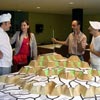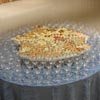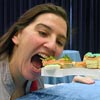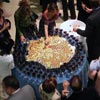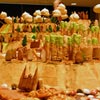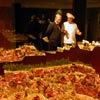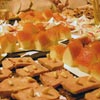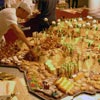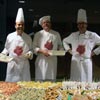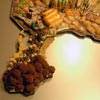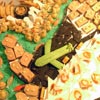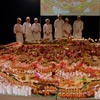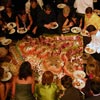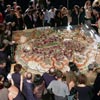Gran Canariaphagy, 2005
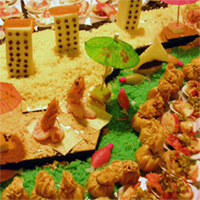 |
In 2005 Alicia Ríos and Bárbara Ortiz were invited by El Colegio de Arquitectos de Las Palmas and La facultad de Arquitectura de la Universidad de Las Palmas to discuss the projects Devorar Madrid and Eating the City, Melbourne. This presentation resulted in Ali&Cia later being commissioned by COAC (Colegio Oficial de Arquitectos de Canarias) to produce Gran Canariaphagy, their first work of islaphagy. The work consitituted COAC's annual Christmas dinner and was held in the Auditorio de Las Palmas de Gran Canaria. The island was reinterpreted with the help of Vanyera3 caterers, HECANSA hospitality school, Pastelería Arbona, and many other collaborators.
Being Ali&Cia's first work of islaphagy it presented new challenges. The two previous works had been of urban centres, now for the first time rural areas were to be represented with the geology and flora of natural landscapes. In addition, as opposed to the relative flat ground of Madrid and Melbourne, Gran Canaria is extremely mountainous, rising in the centre of the island to a height of 1,949 metres. The four 2 x 2m tables that Bárbara Ortíz designed employed five different levels to replicate the topography.
Elaborating on the fact that many of those attending would be travelling to Gran Canaria for the occasion, the presentation of the work was cast as a journey to the edible island. Diners, unaware of what awaited them, received invitations in the guise of boat and plane tickets advising them of their boarding gate and time. Upon entering the auditorium passengers were greeted with four tables upon which platforms in the shape of the island of Gran Canaria supported various canapé illustrating the geology and vegetation of the island. A legend displayed next to each table explained what each type of canapé represented. The maps were also surrounded by a sea of filled wine glasses. The aperitif offered a taste of things to come.
Next, passengers were asked to take their seats, fasten their seatbelts and await take off. Once they were all seated in the dining area the lights went out in the cabin. In the darkness the four tables were brought out and when the lights came up again a video camera relayed images of the mountains and valleys of the edible island of Gran Canariafagia onto the cabin's screens as if the dinning room was coming in to land. Upon landing, Alicia welcomed the passengers and invited them to take a closer look at their destination before the catharsis commenced. Crowds gathered to decode the island, their eyes roaming over a familiar landscape seen afresh, many taking photos.
Visitors to the island were first offered crackers made using pintaderas- molds created by the indigenous population hundreds of years ago- and served a traditional watercress soup as found in the water reserves of the edible island. They were then invited to serve themselves from the island and the catharsis of urbanophagy began.
It's a curious sight watching participants approach an edible artwork as it is often with a mixture of enthusiasm, reverence and apprehension. They look on eagerly, keen to fill their plate but often hesitating to decipher what is before them or unsure they want to destroy it.
The chefs did a magnificent job, creating a richly textured work full of insight and humour. There were villages of fresh cheese houses with quince jelly roofs, goat in the rocky mountain areas of papas arrugadas (a typical dish of small local potatoes) and an abundance of sea food off the coast. An area with many German residents was represented with a sacher torte, a rich chocolate cake from Austria, and the bishop's summer residence was marked with a pastry called bishop's tongue, lengua de obispo. There was soil of gofio, a toasted flour eaten by the locals for hundreds of years, and couscous beaches, a reference to the immigrants that arrive in boats from Morocco, peopled with sunbathing gambas, prawns also being a term used to describe sunburned foreigners!
Press
Cena de Navidad: Islafagia, el arte de comer el territorio(download pdf)
Isabel Peligero, BASA, nº 29, 2006, pp. 140-141.
Ali&Cia acerca la ciudad a sus habitantes con edificios comestibles
Cira Morote Medina, La Provincia, Diario de Las Palmas, 15/4/2005, p. 51.
Video
Gran Canariafagia(see video)
Video by Diego Vega for Ali&Cia (Spanish)
|
